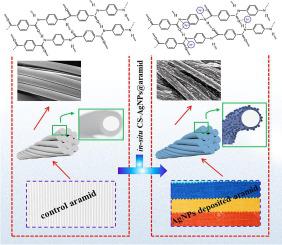当前位置:
X-MOL 学术
›
Inorg. Chem. Commun.
›
论文详情
Our official English website, www.x-mol.net, welcomes your
feedback! (Note: you will need to create a separate account there.)
Coloration of aramid fabric via in-situ biosynthesis of silver nanoparticles with enhanced antibacterial effect
Inorganic Chemistry Communications ( IF 4.4 ) Pub Date : 2020-09-01 , DOI: 10.1016/j.inoche.2020.108115 K.M. Faridul Hasan , Haona Wang , Sakil Mahmud , Cao Genyang
Inorganic Chemistry Communications ( IF 4.4 ) Pub Date : 2020-09-01 , DOI: 10.1016/j.inoche.2020.108115 K.M. Faridul Hasan , Haona Wang , Sakil Mahmud , Cao Genyang

|
Abstract This work has found innovative multicolored and antibacterial effects on aramid fabrics through an in-situ synthesis of silver nanoparticles (AgNPs) without using any toxic reagents. Chitosan was only used as a renewable reducing and stabilizing agent. As-synthesized products were studied in terms of surface plasmon resonance (SPR), morphology, elemental mapping, metal composition, as well as the chemical interaction between compositing constituents. Results revealed that the particles are mostly in spherical shapes, uniformly dispersed and tightly attached to the aramid surface by molecular force or double network developed by chitosan. The treated fabrics also revealed improved thermal resistivity and sustainable color properties in terms of color uniformity, strength (K/S), and fastness ratings. They also have demonstrated excellent antibacterial action with more than 99% bacterial reduction efficiency against both Escherichia coli (E. coli) and Staphylococcus aureus (S. aureus) even after 10 washing cycles. Overall, this technique of aramid treatment could be a benchmark for sustainable multicolored and durable antibacterial performances in a more sustainable way.
中文翻译:

通过原位生物合成具有增强抗菌作用的银纳米粒子为芳纶织物着色
摘要 这项工作通过原位合成银纳米粒子 (AgNPs),在不使用任何有毒试剂的情况下,发现了对芳纶织物的创新多彩和抗菌作用。壳聚糖仅用作可再生的还原剂和稳定剂。在表面等离子体共振 (SPR)、形态、元素映射、金属成分以及复合成分之间的化学相互作用方面研究了合成产物。结果表明,颗粒多呈球形,均匀分散并通过分子力或壳聚糖形成的双网络紧密附着在芳纶表面。处理过的织物在颜色均匀性、强度 (K/S) 和牢度等级方面还显示出改进的耐热性和可持续的颜色特性。即使经过 10 次洗涤循环,它们也表现出出色的抗菌作用,对大肠杆菌(E.coli)和金黄色葡萄球菌(S.aureus)的细菌减少效率超过 99%。总体而言,这种芳纶处理技术可以以更可持续的方式成为可持续多色和持久抗菌性能的基准。
更新日期:2020-09-01
中文翻译:

通过原位生物合成具有增强抗菌作用的银纳米粒子为芳纶织物着色
摘要 这项工作通过原位合成银纳米粒子 (AgNPs),在不使用任何有毒试剂的情况下,发现了对芳纶织物的创新多彩和抗菌作用。壳聚糖仅用作可再生的还原剂和稳定剂。在表面等离子体共振 (SPR)、形态、元素映射、金属成分以及复合成分之间的化学相互作用方面研究了合成产物。结果表明,颗粒多呈球形,均匀分散并通过分子力或壳聚糖形成的双网络紧密附着在芳纶表面。处理过的织物在颜色均匀性、强度 (K/S) 和牢度等级方面还显示出改进的耐热性和可持续的颜色特性。即使经过 10 次洗涤循环,它们也表现出出色的抗菌作用,对大肠杆菌(E.coli)和金黄色葡萄球菌(S.aureus)的细菌减少效率超过 99%。总体而言,这种芳纶处理技术可以以更可持续的方式成为可持续多色和持久抗菌性能的基准。











































 京公网安备 11010802027423号
京公网安备 11010802027423号